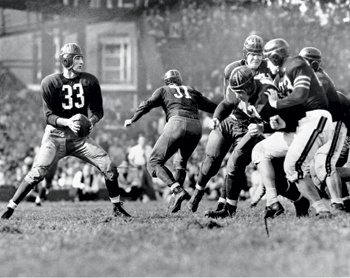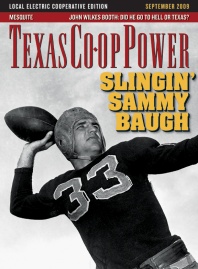On a Saturday morning more than 50 years ago, Dad roused my brothers and me out of bed and drove us to Holt’s Sporting Goods in downtown Waco. Holt’s was where we stocked up every season on baseball gloves and bats, but on this morning he wanted us to meet someone.
“Boys, meet Slingin’ Sammy Baugh,” he said, nudging us toward a tall, dark-haired man in a sport coat and slacks, who smiled down at us, shook our hands and signed an autograph. Kenny, Steve and I had no idea who he was.
Sportswriter Dan Jenkins could have told us. Jenkins grew up in Fort Worth and saw Baugh play football at Texas Christian University in some of the epic battles of the old Southwest Conference.
“I still think he’s the greatest quarterback who ever lived, college or pro,” Jenkins told me.
Baugh revolutionized the game of football. A living link between the leather-helmet era and the modern, he spread the field, opened up the game and made the forward pass a strategic weapon, not a desperation heave. He made quarterback the glamour position, which means that Brett Favre, Donovan McNabb, Peyton Manning and all the other football field generals since Baugh are in his debt.
After his All-American career at TCU, Baugh led the Washington Redskins to five title games and two NFL championships, while leading the league in passing six times and in punting four times. In 1943, the triple-threat Baugh, who also played defensive back, recorded a triple crown when he led the NFL in passing, punting and interceptions.
Born in 1914 in Temple, Samuel Adrian Baugh spent his high school years in Sweetwater, where he starred on the high school football, basketball and baseball teams.
After high school, he enrolled at TCU, where he earned nine letters in those same three sports. But it’s in football where Baugh really made his mark, leading the Horned Frogs to Sugar Bowl and Cotton Bowl wins in 1936 and ’37, respectively.
Soon, the Redskins called to congratulate him on being their No. 1 draft pick. “I didn’t know what they were talking about, because frankly, I had never heard of either the draft or the Washington Redskins,” he told sportswriter Whit Canning a few years back.
Redskins owner George Preston Marshall offered Baugh a $5,000 contract. His college football coach and mentor, Dutch Meyer, advised him to hold out for $8,000. Marshall met his demand, making the young Texan the team’s highest-paid player.
When Baugh reported to the Redskins, as the story goes, Coach Ray Flaherty handed the ball to the rookie and said, “They tell me you’re quite a passer.”
“I can throw a little,” Baugh said.
“Let’s see how good,” Flaherty said. “Hit that receiver running down the field in the eye.”
“Which eye?” Baugh drawled, never looking up.
It didn’t take Flaherty long to realize what he had. “That’s the greatest passer football has ever seen,” he said after the first day’s practice. Marshall also realized what he had and relentlessly marketed his rookie quarterback as Slingin’ Sam, a real West Texas cowboy. Never mind that the young man had grown up in town and had rarely been on a horse. Marshall outfitted him in a new pair of boots and a Stetson to meet the press in Washington, D.C.
A reporter asked him about the boots he was wearing. “They hurt my feet,” Baugh complained.
Marshall quickly got returns on Baugh’s Western duds and high salary. In 1937, the rookie led the Redskins to a division championship in their first season in Washington, which set the stage for one of the epic battles in the early years of the NFL.
Minutes into the 1937 National Football League championship game, the Chicago Bears had the visiting Redskins precisely where they wanted them.
With a stark and punishing wind off Lake Michigan knifing into Wrigley Field, and players wearing rubber-soled basketball shoes to get some minimal purchase on the stone-cold ground, the Redskins looked to be in trouble on their own 5-yard line. They huddled in their own end zone around their remarkable rookie quarterback, a tall, skinny kid who had performed miracles for them all year.
“Punt formation,” 23-year-old Sammy Baugh told his teammates—as everyone in the stadium could have predicted—“but we’re gonna pass.”
Years later, Baugh would tell a writer: “I sure got some weird looks on that one.” As well he should have. Before Baugh, teams rarely passed, except in third-and-long desperation situations. And certainly not from their own end zone.
The Redskins broke the huddle, and on the snap the Bears’ front line scratched, clawed and burrowed ahead, intent on blocking the punt. The 6-foot-2-inch Baugh calmly flicked a pass to his halfback, Cliff Battles, who rambled 42 yards before being pulled down. A few plays later, the Redskins scored en route to a 28-21 victory and their first NFL championship in their first season in Washington.
The rookie quarterback was awesome on that cold December afternoon, completing 17 of 34 passes for 352 yards, 4 yards more than the entire Chicago offense. He threw touchdown passes of 35, 55 and 78 yards.
In 1941, George Preston Marshall’s faux cowboy had become the real McCoy, when he paid $200 an acre for a ranch on the rugged, rolling plains of West Texas, 80 miles northwest of Abilene and not far from the Double Mountain Fork of the Brazos River. Six distant gates from the nearest paved road, the old ranch house in the shadow of Double Mountain at first had no electricity and no running water. The toast of Washington and his young wife, the former Edmonia Smith, took baths in a horse trough.
During the first two seasons with the Redskins, Baugh and his wife lived in an apartment in a Washington suburb. After moving to the ranch and after the children started coming—the Baughs had four boys and a girl—Edmonia stayed home to manage the household and run the ranch. He lived in a Washington hotel for six months of the year and hurried back to West Texas when the season was over.
On November 23, 1947, on Sammy Baugh Day at Washington’s Griffith Stadium, he threw six touchdown passes as the Redskins defeated the Chicago Cardinals—who would go on to win the NFL title that year—45-21. In his 16 seasons in the NFL, all with the Redskins, he invariably gave fans some eye-popping Slingin’ Sam performance to rave about, whether it was his passing, his running, his punting, his defensive play or some combination of the four. During several seasons early in his career, he played every minute of every game.
And then he walked away. Retiring after the 1952 season, Baugh left Washington and headed back to Texas. He coached the Hardin-Simmons University Cowboys from 1955-59; the New York Titans—forerunner to the New York Jets—from 1960-61; and the Houston Oilers of the fledgling American Football League in 1964.
Then he abandoned football, plunging into the West Texas ranching life that he loved far more than the game he played so well. To one of the finest athletes of his era, and the most popular Redskin of his time, perhaps of all time, football was only a game.
It’s not as if he didn’t enjoy the game. As son David noted, he loved the challenge, both physical and mental. But in the end, it was just a game. The ranch was his life. “He told me one time that if he had it all to do over again, he wouldn’t be a big athlete,” David told me. “He’d be a rancher, a roper, a cowman.”
Actor Robert Duvall told me a couple of years ago about visiting with Baugh as Duvall prepared for the role of Augustus “Gus” McCrae in the TV miniseries “Lonesome Dove.” Duvall listened to Baugh’s stories, played golf with him and slapped down dominoes across a table from him in the old ranch house.
He got to watching Baugh’s hands as the old man told his tales. They were no longer the large, long-fingered hands that at one time could grip a leather spheroid and toss it on a line 60 yards, but those of a working rancher—strong, weathered hands that for more than half a lifetime had mended fences, roped and branded cattle and castrated calves.
“In just a couple of hours, Sammy Baugh gave me the finishing touches for Augustus McCrae, and he didn’t even know it,” Duvall said.
For many years—actually for much longer than he was a football star—Baugh was a full-time rancher. Some of his West Texas neighbors didn’t even know he had played football.
In 1990, his beloved Edmonia died, and that was about when time began running down for Slingin’ Sam as well. He hung in for a few years, until a broken hip robbed him of his remaining mobility and Alzheimer’s disease ravaged his agile mind and erased the golden gridiron memories.
Baugh, the last surviving member of the Pro Football Hall of Fame’s inaugural class of 1963, died on December 17, 2008, at a hospital in Rotan. He was 94. The saddle he sat and the chaps he wore while working on the ranch were draped over his coffin at the front of Rotan’s First Baptist Church. A horse-drawn wagon carried him to his final resting place. A dozen black Brangus cattle stood at the graveyard fence, watching.
——————–
Joe Holley, a former editor of Texas Co-op Power, is a staff writer for The Washington Post and the author of a forthcoming biography of Sammy Baugh.
Sammy Baugh’s ranch was served by Big Country Electric Cooperative.


